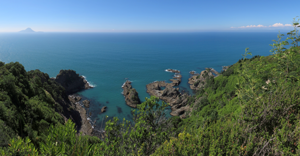
Photo Credit: Thomas Jundt – CC BY-NC 2.0
The name Te Moana-a-Toitehuatahi (the sea of Toitehuatahi) recalls Toi, a famous tupuna with connections to many hapū throughout Te Ika-a-Māui (the North Island). The bay has been home to his descendants for many generations. A rich variety of stories and places are associated with Toitehuatahi (also known as Toikairākau), including Kaputerangi pā. Another place name is Te Puku-o-te-wheke (the centre of the octopus), just west of Whakātane. The tentacles of the octopus symbolise the sphere of Toi’s influence, while its centre indicates his home.
Cook arrived in Te Moana-a-Toitehuatahi in November 1769. He did not name the bay in his journal, but wrote ‘Bay of Plenty’ on his maps. In his journal, he commented ‘we saw a great deal of Cultivated land laid out in regular inclosures a sure sign that the Country is both fertile and well inhabited’. He was probably comparing it to the land further south that he had dubbed ‘Poverty Bay’. Naturalist Joseph Banks was more obvious in his comparisons, noting: ‘we judgd the countrey to be much better peopled hereabouts and inhabited by richer people than we had before seen’. Most of their observations were made from the deck of a ship out at sea and may be inaccurate, but both names (and their connotations) have endured.
The name ‘Bay of Plenty’ also refers to the region as well as the body of water. Many regions or area boundaries were not always strictly defined; in fact, when the Secretary of the New Zealand Geographic Board was asked to define it by the Tauranga County Council Engineer in 1956, he refused to do so. However, in 1989 the current Bay of Plenty Region was established with defined boundaries extending south almost to Lake Taupo (Taupomoana).
References
- NZ Gazetteer, Bay of Plenty
- Te Ahukaramū Charles Royal, 'First peoples in Māori tradition - Toitehuatahi', Te Ara - the Encyclopedia of New Zealand
- James Cook, ‘1 November 1769’, South Seas: Voyaging and Cross-Cultural Encounters in the Pacific (1760-1800)
- Joseph Banks, ‘2 November 1769’, South Seas: Voyaging and Cross-Cultural Encounters in the Pacific (1760-1800)
- NZGB Correspondence, 21 March 1956, Vol. 30, pp. 291-292